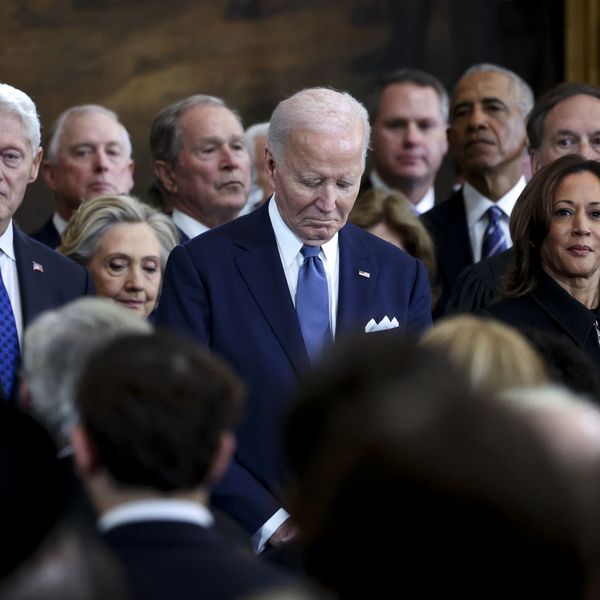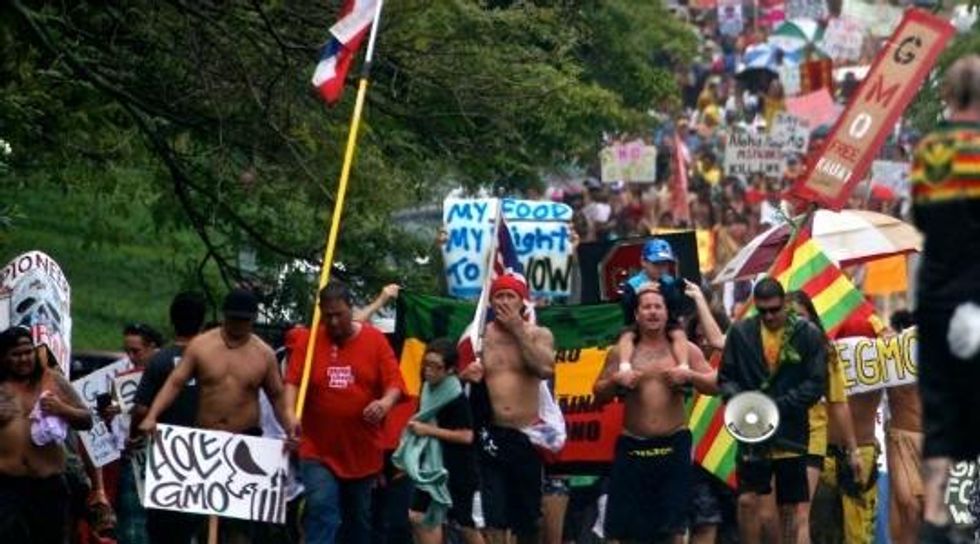There is a powerful and growing movement in Hawaii to protect our land, water and people's health from the impacts of the agrochemical-GMO industry -- corporate giants Dow, Pioneer DuPont, Syngenta,
Monsanto, BASF. The industry has been using our fragile and treasured islands since the 1990s as one of their main testing grounds for experiments engineering new chemical-crop combos, biopharmaceuticals, and other agrochemical products. They pollute our environmental commons as they pirate ("patent") our global genetic commons in order to make massive amounts of wealth for a very few.
In our struggle, we are connected in solidarity with people around the world who are facing varied forms of exploitation and devastation stemming from the corporate capitalist food system. From land-grabbing and hunger, to farmer debt and agricultural slave-labor, to deforestation and climate change, our struggles are connected by a common root -- a food system driven by the logics of commodification, profit-maximization and concentration of wealth and power. We resist and build together, inspired by our knowing that a more democratic, sustainable and equitable food system is not only possible, but that it is what the vast majority of us want.
We share our story as part of this rising awareness of our common struggle.
Since GMO testing began in Hawaii, over 3,000 permits have been granted for open-air field trials, more than in any other state in the nation. In 2012 alone, there were 160 such permits issued on 740 sites. Kauai, the fourth largest of the main islands and known as the "Garden Isle," has the highest number of these experimental sites. On Kauai alone these sites are associated with the use of 22 "restricted-use pesticides" (RUPs) in the amount of approximately 18 tons of concentrate each year, as well as perhaps 5 times that amount of non-restricted pesticides such as glyphosate.
We know, from information obtained solely due to a lawsuit, that Pioneer DuPont alone has used 90 pesticide formulations with 63 active ingredients in the past 6 years. They apply these pesticides around 250 (sometimes 300) days each year, with 10-16 applications per day on average. For a small island ecosystem, these numbers are astounding. We have no similar information from any of the other companies -- Dow, Syngenta or BASF.
The agrochemical-GMO industry occupies nearly all of the leased agricultural lands on the west side of Kauai -- in total over 15,000 acres in close proximity to schools, residences, hospitals and waterways. More than half of these lands are State Lands, disputed lands that were usurped in the overthrow and following US annexation of the independent Kingdom of Hawaii. At the very least, according to the State's own laws, these lands are to be managed for the common good of Hawaii's people, and especially for the betterment of the conditions of Native Hawaiians.
The industry often states that they came to Hawaii because we have a year-round growing season. But it's not just our good weather they were after. They came because they saw us as an exploitable community, left with an economic void when the sugar plantations hastily exited. Our state was challenged to think outside of the box of plantation agriculture after 150 years of it. The agrochemical-GMO companies saw a community of mostly working-class people, already conditioned to accept an industry that exports all of its profits and leaves behind nothing but pollution, health bills and unsafe, low-paying jobs. They came because, despite our enlightened state motto -- Ua Mau ke Ea o ka 'Aina i ka Pono (the life of the land is perpetuated in righteousness) -- we allow them to get away with doing things that they wouldn't be allowed to do in many other places.
Residents of Kauai currently do not have the right to know what is happening on our agricultural lands, nor how these activities are affecting our common air, water and soil. We do not know which pesticides are being used, where, in what amounts, how they are being mixed, or what their cumulative impacts might be. We also know nothing about the experimental GMO crops being tested. Even when the federal government determines that new pesticide-GMO crop combos significantly affect the quality of the human environment -- as the USDA did in the recent case of 2,4-D and dicamba resistant crops -- we have no way of knowing whether they were tested here and what their impacts might have been.
We are currently struggling to pass a Kauai County bill that would require pesticide disclosure and set-up a buffer zone between the spraying and residential areas. The bill would require that the county conduct an Environmental Impact Statement, and in the meantime put a moratorium on new operations. It would also mandate that experimental pesticides and GMOs be tested in containment rather than in the open-air.
The pesticides the bill pertains to are not the type you purchase at Ace Hardware. They are "restricted-use pesticides" (RUPs) because they are recognized as extremely dangerous. Atrazine (produced by Syngenta), for example, is known to cause birth defects, cancer and reproductive issues. Lorsban (produced by Dow) is known to cause impaired brain and nervous system functions in children and fetuses, even in minute amounts. The EPA has determined that the risks to children are so severe, Lorsban should not be used anywhere they could be exposed. Studies show that other RUPs being used are linked to brain cancer, autism, and heart and liver problems.
Despite national laws that prohibit RUP drift, atrazine, chlorpyrifos (Lorsban) and bifenthrin have made it into the drinking water or air at Waimea Canyon Middle School, almost certainly the result of spraying by the chemical-GMO operations around the school. On several occasions children and teachers have become very ill. In one incident at least 10 children collapsed and were sent to the hospital. An investigation into the matter was strikingly incomplete, testing for only 6 of the 63 active pesticide ingredients used on just one of several neighboring operations, and completely neglecting acute exposure.
It is morally abhorrent that the companies have refused to disclose even the most basic information we need to protect our health, and are now fighting our very reasonable attempt for more transparency. The severity of their backlash and the massive resources they are pouring into subverting our efforts is clear indication that they consider transparency a real threat. These corporations are accustomed to externalizing all of their costs onto workers, communities and the environment. The prospect of being held accountable is an alarming one because their massive profits come at the expense of forcing the rest of us to pick up their health and environmental remediation bills.
Their tactics have been predictably vile. As they are doing to farmers, communities and nations across the globe, they are threatening to sue us. They are claiming that under Hawaii's "Right to Farm Act" they are not responsible for any off-sight impacts. At the same time they are marketing themselves publicly as "responsible community members" and "stewards of the land." They are buying local lobbyists with connections. They are breaking national laws and then claiming they are already over-regulated. They are slandering scientists who raise questions. They are outright lying, deceiving and offending our intelligence.
Most upsetting for our community, these corporations are threatening to take away the jobs of our friends and neighbors if we force them to disclose their chemical use. Syngenta has had the audacity to tell their workers that they may decide to close shop on July 31, the day of the bill's public hearing. They paid their workers to attend the first hearing, and it is likely that they will fly people in for the second. Similar to many other environmental justice issues, the west side community is one of the most economically disadvantaged in the State. It also has one of the highest Native Hawaiian populations. Workers are being told that their only option is to support the long-term poisoning of their families and the land many of them have inhabited for generations, or risk loosing their livelihoods. While the industry's scare tactics are somewhat transparent, they invoke very real and legitimate fear.
According to the industry's own high (undocumented) claims, they provide roughly 2% of jobs on the island. At least half of these are part-time, seasonal jobs. They bring in temporary cheaper labor from other countries, undercutting the ability of local workers to push for better wages and working conditions. Foreign "guest-workers" are amongst the most vulnerable for workplace abuses. Most, if not all, of the well-paying, managerial and "high-tech" jobs go to people from the mainland.
The people of Kauai are building an alternative vision. One in which our economy is more equitable and resilient, and not dependent on the whims of transnational corporations who can leave at any moment. One in which we grow healthy food for ourselves, in a way that is consistent with the value of malama `aina (care for the land). One in which our agricultural jobs are safe and long-term, and benefits accrue to the workers rather than transnational corporations. As an island dependent on barges coming from at least 2500 miles away for 85% of our food, there are huge possibilities.
Locally and globally, we do face real structural challenges to building a more fair and sustainable food system. However, possibilities are already present that can begin to move us in the right direction. At a local level in Hawaii, just a few examples include: making state lands available and affordable for real farmers, upholding the public trust doctrine in water law, workers' cooperatives, research and subsidy support for sustainable regional food systems, food hubs for cooperative processing and distribution, supporting soil and water remediation, state ag parks, food assistance programs, local food procurement policies, waste reduction and recycling programs, stronger labor protections, and regulations that prohibit pollution of the finite resources we depend upon.
Critically, these steps must be part of the global movement to change the underlying logics of the system. We must resist the structural conditions that create a radically immoral food system, while we build towards vantage points that allow us to imagine other possibilities. Perhaps, acting in solidarity, the constraints are not as great as we think them to be, and what we need above all is to believe that we are actually capable of creating a more equitable, sustainable and democratic food system. And so we share our story, as part of the rising global movement that does indeed believe.



